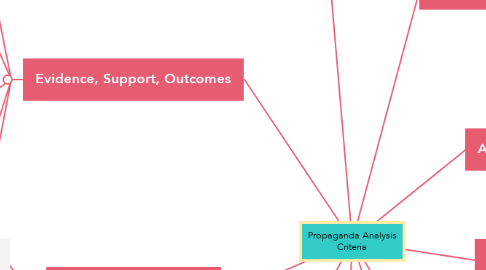Propaganda Analysis Criteria
by Jasmine Dowden

1. Author
1.1. Who wrote the message?
1.2. What are the writer's motives for creating this message?
1.3. How might the write personally benefit from the audience's acceptance of this message?
2. Evidence, Support, Outcomes
2.1. What facts and specific details does the document use? Are the facts verifiable and believable?
2.2. What emotions does the document use to communicate its message? How is the audience likely to feel when they read this message?
2.3. What ethical or moral values does the document use to communicate its message? What relevant values are not supported by this message?
2.4. What will happen if the audience accepts this message?
2.5. What would happen if everyone in the world accepted this message?
3. Overall Impression and Conclusions
3.1. What is the overall impression of this message? Summarise the details that you have gathered in your analysis
3.2. How would you categorize this poster—argument, persuasion, or propaganda? Explain your choice
4. Content
4.1. What is in the foreground?
4.2. What is in the background?
4.3. What figures are used? How are they positioned? Does this suggest anything important?
4.4. What kind of symbolism has the composer used?
4.5. What do these symbols represent?
5. Reliability
5.1. Is the source consistent with data available about the topic?
5.2. Are there other sources which could validate the information given from this source?
5.3. Does it have scholarly credibility? Where was it published? How was it published?
5.4. Does the source fulfill an agenda? i.e. was the source produced for an opinion/stance, or was the stance a product from the source?
6. Purpose
6.1. What is the message that this document communicates? What is the documents purpose?
6.2. Why is it important for this message to be delivered to this audience at this moment in time?
6.3. How does the document communicate its message? Think about its use of language, color, space, and symbols.
7. Audience
7.1. Who is the audience for this document?
7.2. What are the writer’s motives for creating this message? How might the writer personally benefit from the audience’s acceptance of this message?
8. Origin
8.1. Is the source primary, secondary or tertiary?
8.2. When was the source created?
9. Perspectives
9.1. What opinions or belief statements are evident in the article?
9.2. Would another source/composer have a different point of view depending on their background experience?
9.3. What facts are missing? Has anything been intentionally missed out?
9.4. What words and phrases did the source/author use to present the information?
9.5. Why is the source presented in such a way?
10. Usefulness
10.1. Is the source relevant to what is being asked?
10.2. Has the source revealed an insight into the question?
10.3. Is the source reliable in providing the information required to answer the question?


